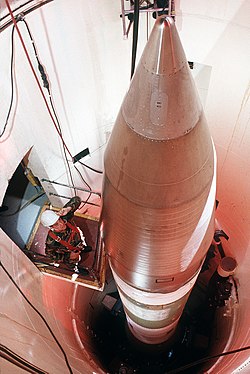| 448th Missile Squadron | |
|---|---|
 Minuteman III in silo near Grand Forks AFB in 1989 | |
| Active | 1942–1945; 1947–1949; 1959–1961; 1965–1997 |
| Country | |
| Branch | |
| Type | Squadron |
| Role | Intercontinental ballistic missile |
| Motto(s) | In Aquilae Cura (Latin for 'Under the Care of the Eagle') |
| Engagements | Mediterranean Theater of Operations |
| Decorations | Distinguished Unit Citation Air Force Outstanding Unit Award |
| Insignia | |
| 448 Missile Sq emblem [a] [1] |  |
| 448th Strategic Missile Squadron emblem [b] [1] |  |
| 448th Bombardment Squadron emblem [c] [2] |  |
| 448th Bombardment Squadron emblem (World War II) [3] |  |
The 448th Missile Squadron is an inactive United States Air Force unit. It was last assigned to the 321st Missile Group at Grand Forks Air Force Base, North Dakota. The 448th was equipped with the LGM-30 Minuteman intercontinental ballistic missile, with a mission of nuclear deterrence. With the end of the Cold War, the 448th was inactivated on 23 September 1997.
Contents
- History
- World War II
- Reserve operations
- Strategic bomber unit
- Intercontinental ballistic missile squadron
- Lineage
- Assignments
- Stations
- Aircraft and missiles
- Awards and campaigns
- See also
- References
- Notes
- Bibliography
The squadron was first activated in 1942 as the 448th Bombardment Squadron and was equipped with North American B-25 Mitchell medium bombers. After training in the United States, it deployed to the Mediterranean Theater of Operations, serving in combat until 1945. The squadron earned a Distinguished Unit Citation for its actions. After the war, it returned to the United States and was inactivated.
The squadron was briefly activated in the reserve from 1947 to 1949, but does not appear to have been fully manned or equipped with operational aircraft. It was activated in 1953 as a Strategic Air Command bomber unit, serving until 1961, when its Boeing B-47 Stratojets were replaced by Boeing B-52 Stratofortresses. It was organized in February 1965 as the 448th Strategic Missile Squadron.





